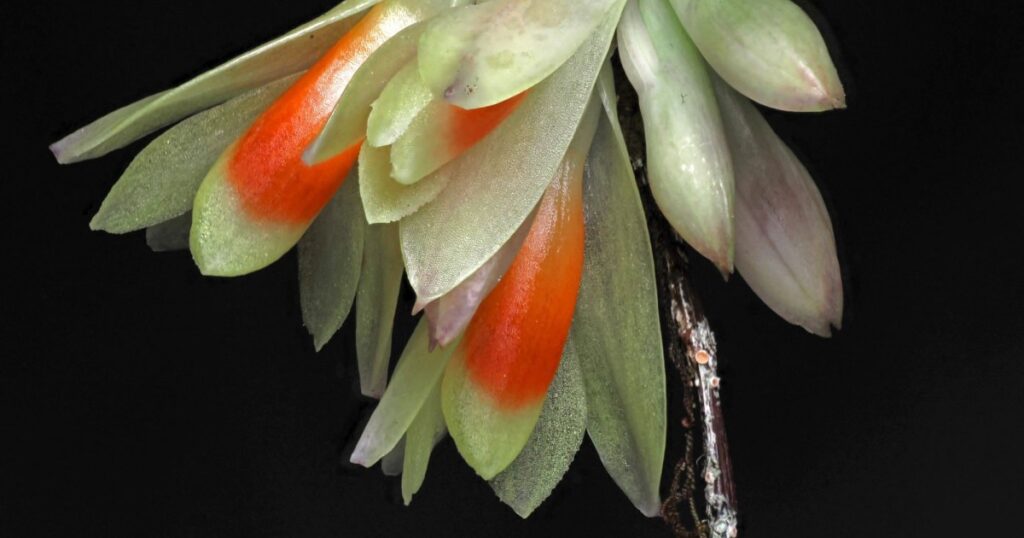Dendrobium wanmae, an orchid found on a remote mountain summit in Indonesia.Cover Images/ZUMA Press
This story was originally published by the Guardian and is reproduced here as part of the Climate Desk collaboration.
From a toadstool with teeth to a vine smelling of marzipan and a flower that has cheated its way out of having to photosynthesize, a weird and wonderful host of new plant and fungus species have been discovered in 2024.
Other plants given scientific names for the first time include beautiful new orchids, a ghostly palm, and a hairy plant that appears to have stolen a gene from an unrelated family. The species are among the 172 new plants and fungi named by scientists from the Royal Botanic Gardens, Kew, and their partners.
The species come from every corner of the globe, from woods near Tunbridge Wells in Kent in England, to African sandstone cliffs in Guinea and the forests of Indonesia.
However, botanists are in a race against time to discover many plants and fungi before the continuing destruction of the natural world drives them to extinction. The loss of species does not only mean that their unique biology is gone forever, but also their potential for use as medicine, food, and even as plastic recyclers. Some of the new species in 2024 already face extinction because of cement manufacturing, cinnamon farming, and timber plantations.
There are 400,000 named plant species but scientists estimate there are another 100,000 yet to be identified. Every year, scientists name about 2,500 new species of plant and the same number of fungi.
“The sheer privilege of describing a species as new to science is a thrill that not many will ever get to experience.”
“The sheer privilege of describing a species as new to science is a thrill that not many will ever get to experience,” said Dr Martin Cheek, in RBG Kew’s Africa team. “Sadly, the devastating reality is that more often than not, new species are being found on the brink of extinction and it’s a race against time to find and describe them all.”
About 40 percent of named plant species are threatened with extinction, as habitats are razed for farmland and other human development, and as many as 75 percent of the world’s undescribed plant species are thought to be threatened with oblivion.
Toadstools most often have gills or pores under the caps to disperse their spores but those from the genus Phellodon have rows of teeth-like protuberances. This year DNA analysis revealed three new species in the UK, from woodland near Tunbridge Wells and Windsor in England, and Abernethy in Scotland. These fungi are harmed by nitrate pollution from farming and are disappearing across Europe.
Other new fungi include three species of toadstool from the genus Russula – which often give off a fishy whiff—from northern Sweden and Norway, the high Rockies in the US, and British Columbia in Canada.
Dr Anna Bazzicalupo, a fungi expert at RBG Kew, said: “Identifying new species of fungi is a colossal but increasingly important task as we estimate more than 2m species are waiting to be described. An overwhelming number of them are likely threatened with extinction, meaning they may disappear before they are even recognized.”
Three more new lianas were found in southern China. These flower only at night and are pollinated by moths. One, Cheniella longistaminea, can grow up to 80 meters tall but all are threatened by plantations of timber and cinnamon, with the latter being a big export to the US. Another new liana in Vietnam, Chlorohiptage vietnamensis, grows in a limestone landscape that is being cleared for cement quarries. Scientists do not know what kind of insect pollinates its strange green flowers.
Botanists also revealed a new family of cheats in 2024, called Afrothismiaceae. The rare plants, found mostly in forests in Cameroon, do not use sunlight to photosynthesize sugars and have lost their green color. Plants usually provide these sugars to mycorrhizal fungi in their roots in exchange for minerals. But the Afrothismiaceae species take all they need from their fungal partners, giving nothing in return, and only appear above ground to fruit and flower.
Another rule-breaker is a new herb from Guinea in West Africa, named Virectaria stellata, which grows on the remote sandstone cliffs of the Fouta Djallon. It has star-shaped clusters of hair, which have never been seen in this large family before. But these hairy stars do occur in plants from an unrelated genus called Barleria. The botanists think the genes that produce the stellate hairs may have jumped from one family to the other via sap-drinking insects.
Among the most spectacular new species, are a bonanza of orchids from Indonesia, which still hosts many unknown species across its 17,000 islands. A climbing palm in western Borneo was also named in 2024, Plectocomiopsis hantu. Hantu is the local word for ghost, used because the plant has grey stems and white undersides to its leaves and it is known from only three rainforest locations. Local communities, however, have long used it to make baskets and for its tasty and tender roots.
Cheek said: “Biodiversity loss is a crisis that affects us all. Every unknown species we lose could have been a potential new food or new medicine that we never even knew existed. We urgently need more funding, training, and public awareness of plant and fungal taxonomy.”

